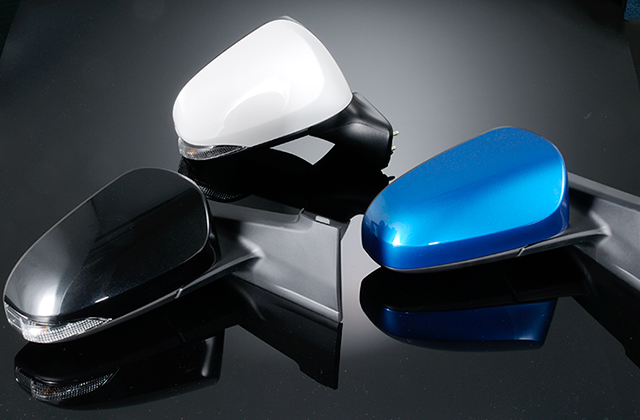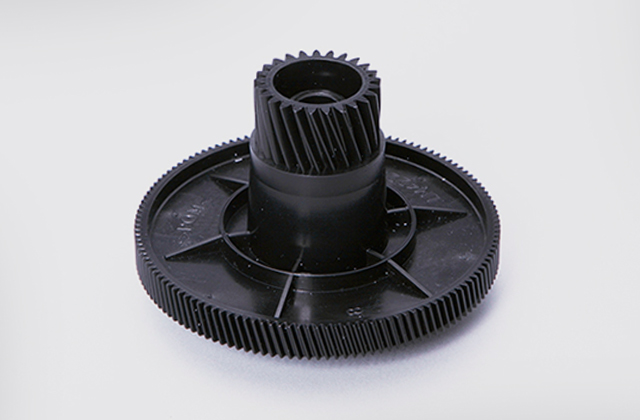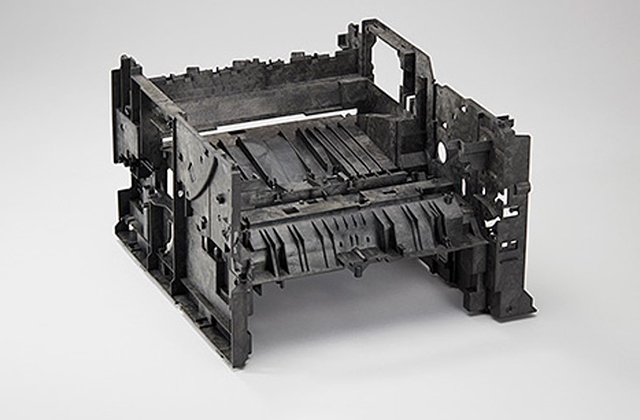1トラブルの内容 : 樹脂が食い込まない
|
主な原因 |
主な対策 |
| 1. |
スクリューの溝の深さよりもペレット粒子や粉砕品の径が大きすぎる |
ペレット粒子または粉砕品を小さくするか、成形機またはスクリューを交換します |
| 2. |
シリンダー温度が低すぎて、樹脂が溶けない |
シリンダー温度を上げます |
| 3. |
ホッパー下のスクリューに固化した樹脂が巻き付いている
(ホッパー下を冷却せずに成形したとき起こることがあります) |
固化樹脂を、除去します |
2トラブルの内容 : ノズルから樹脂が出ない
|
主な原因 |
主な対策 |
| 1. |
未溶融樹脂によるノズル詰まりが考えられます |
シリンダーの温度を上げます |
| 2. |
溶融樹脂がノズルで固化して詰まったことが考えられます |
ノズル温度を上げます |
| 3. |
異物によるノズル詰まりが考えられます |
ノズルを分解掃除すると共に、異物混入防止の対策を取ります |
3トラブルの内容 : ノズルから発泡した樹脂が出る
|
主な原因 |
主な対策 |
| 1. |
シリンダーの温度が高すぎて樹脂が分解したことが考えられます |
シリンダーの温度を下げます |
| 2. |
水分が多くて、水分の気化又は樹脂が加水分解したことが考えられます |
ペレットまたは再生材を乾燥します |
4トラブルの内容 : ノズルから鼻たれがある
|
主な原因 |
主な対策 |
| 1. |
溶融粘度が低い樹脂では、鼻たれが起きる場合があります。 |
スクリューのサックバックを適当にとります |
| 2. |
水分が多くて、樹脂が加水分解し、溶融粘度が下がった事が考えられます |
ペレットまたは再生材を乾燥します |
5トラブルの内容 : ノズルから出る溶融樹脂の中に樹脂の固まりがある
|
主な原因 |
主な対策 |
| 1. |
樹脂が十分溶けていないことが考えられます |
シリンダーの温度を上げます |
| 2. |
スクリュー回転数が速すぎるとシリンダー壁からの熱の移動が悪くなります |
スクリュー回転数を下げるか背圧を上げ樹脂の通過時間を遅らせます |
| 3. |
異種樹脂の混入が考えられます |
融点の高い樹脂の混入をチェックして下さい |
6トラブルの内容 : 離型不良
|
主な原因 |
主な対策 |
| 1. |
金型に傷ができた場合に起こることがあります |
傷を修正します |
| 2. |
オーバーパッキングになったとき、起こることがあります |
射出圧力を下げます |
| 3. |
金型の抜きテーパーが小さすぎて、起こることがあります |
抜きテーパーを大きくします |
7トラブルの内容 : スプルーが固定側金型に残る
|
主な原因 |
主な対策 |
| 1. |
スプルーに傷ができて起こることがあります(ノズルタッチ部に特に注意) |
傷を修正します |
| 2. |
ノズルと金型スプルー穴のセンターリングが合っていない時起こることがあります |
金型の取り付け作業をやり直して、センターを合わして下さい |
8トラブルの内容 : シンリダー内に樹脂の充填が出来ない
|
主な原因 |
主な対策 |
| 1. |
溶融粘度が低い樹脂では、鼻たれが原因になる場合があります。 |
- 樹脂を充填するとき、ノズルタッチをしたままシリンダーを回転させ、充填します
- ノズル温度を下げます
- 背圧を下げます
|
| 2. |
樹脂中の水分が多く加水分解が起こり、溶融粘度が下がった事が考えられます |
樹脂の乾燥を行います |
9トラブルの内容 : 樹脂のクッション量が取れない
|
主な原因 |
主な対策 |
| 1. |
逆流防止弁の異常(磨耗など)が考えられます |
逆流防止弁を交換します |
| 2. |
ノズルタッチ部から樹脂漏れが起こっている事が考えられます |
適当な方法で樹脂漏れを防いで下さい(ノズルタッチ部の曲率は合っていますか?) |
10トラブルの内容 : スプルーの糸ひき
|
主な原因 |
主な対策 |
| 1. |
ノズルタッチ部の樹脂が固まらず、粘性が大きくて、型開の時に糸を引き切れない |
- ノズル温度を下げノズルタッチ部の樹脂が固まるようにします
- 冷却時間を長くします
- サックバックを適当に取って下さい
|
| 2. |
ノズルタッチ部から樹脂漏れが起こっている事が考えられます |
適当な方法で樹脂漏れを防いで下さい(ノズルタッチ部の曲率は合っていますか?) |
11トラブルの内容 : ゲートが詰まる
|
主な原因 |
主な対策 |
| 1. |
キャビティーに全充填される前に、樹脂がゲートで固化する |
シリンダー温度、金型温度を上げ、射出速度を速くします |
| 2. |
コールドスラグウェルが浅すぎて、コールドスラグがゲートに流れ込みゲートを詰める |
コールドスラグウエルを深くします |
| 3. |
ペレット又は再生材の中に、融点の高い異種樹脂が混入して、ゲートを詰める |
異種樹脂を除去します |
12トラブルの内容 : 寸法が小さい
|
主な原因 |
主な対策 |
| 1. |
射出圧力が低すぎると、成形収縮が大きくなり、寸法が小さくなる |
射出圧力を上げます |
| 2. |
金型温度が高すぎて、固化時の結晶化度が高くなり、成形収縮が大きく寸法が小さくなる |
金型温度を下げます |
| 3. |
成形品を高熱したに晒すと、結晶化度が進み、寸法が小さくなる |
不必要に高温に晒さないようにします |
13トラブルの内容 : (反り)がある
|
主な原因 |
主な対策 |
| 1. |
金型冷却が不均一なため、変化が起きる |
冷却孔(溝)の位置を改良するか、冷却水量や温度で調整します |
| 2. |
異方性の大きいグレードは、変化が大きい |
- 異方性の小さい樹脂を選びます(ガラス繊維強化グレードは異方性が大きく、無機フィラー入りは小さい)
- 製品形状、金型形状、冷却溝の位置等の見直しを行います製品形状…溶融樹脂がタテ、ヨコ、バランスよく流れるような形状にします。均一の厚みにし、対称形状にします(薄い部分は配向が大きくなります)冷却溝の位置…金型の表面温度が出来るだけ均一になるように、冷却溝の位置を決めます。
CAE利用が有効です金型形状…製品の長手方向に溶融樹脂が流入するように、ゲートの位置を決めます。
ゲートは出来るだけ、フィルムゲートにして、樹脂の流れが、平行かつ幅広く流れるようにします
成形条件…金型温度を低め、冷却時間は長めが適当です
|
14トラブルの内容 : 外観不良 a.アバタ
|
主な原因 |
主な対策 |
| 1. |
金型温度が低く、樹脂が金型表面に馴染まないまま固化した時できやすい |
金型温度を上げます |
| 2. |
射出圧力が低く、樹脂が金型表面に馴染まないまま固化した時できやすい |
射出圧力を上げます |
| 3. |
シリンダー温度が低くて、樹脂温度が十分高くないため樹脂が金型表面に馴染まないまま固化した時できやすい |
シリンダー温度を上げます |
| 4. |
再生材の使用が適当でない(異物の混入、溶融不足など)時できやすい |
再生材使用の見直しが必要です |
15トラブルの内容 : 外観不良 b.ウエルドライン
|
主な原因 |
主な対策 |
| 1. |
温度の下がった流動先端の樹脂が合流する時、合流部は完全に融合せずその表面には、細い線状のマークが残ります |
- 金型温度を高く、射出速度は速くします
- 製品形状…樹脂の流れやすい形状とし、合流する箇所をできるだけ減らし、合流部の樹脂温度が下がり過ぎない程度にゲートの数を増やします。また、合流部は荷重の掛からない位置になるよう設計します
- 金型設計…エアーベントを十分設け樹脂の流れを良くしたり、たまには、オーバーフロータブを設けて低温樹脂部を製品部から追い出すのも有効です
|
16トラブルの内容 : 外観不良 c.ジェッティング
|
主な原因 |
主な対策 |
| 1. |
固化しかかった樹脂の一部が金型内であとからきた溶融樹脂に押されて蛇行状に移動した跡と考えられています |
- 射出速度を遅くします
- ゲートサイズを大きくします
|
17トラブルの内容 : 外観不良 d.ショートショット
|
主な原因 |
主な対策 |
| 1. |
計量が不足している |
計量(ストローク)を大きくします |
| 2. |
射出圧力が低く樹脂が十分に流れない時に起こります |
射出圧力を上げます |
| 3. |
金型温度が低く樹脂の固化が速く起こり十分に流れない時に起こります |
金型温度を上げます |
| 4. |
樹脂温度が低く樹脂の固化が速く起こり十分に流れない時に起こります |
シリンダー温度を上げます |
| 5. |
射出速度が遅くキャビティーの先端に樹脂が行き着く前に固化が起こる時 |
射出速度を上げます |
| 6. |
射出時間が短すぎる |
射出時間を長くする |
| 7. |
製品形状……極端な薄肉部では樹脂の流れが悪くなって固化が起こります |
極端な薄肉部をなくします |
| 8. |
金型形状……多数個取りの場合、ランナーバンスやゲートバランス悪くて一部のキャビティーにショートショットが発生することがあります |
ランナーバランスやゲートハーランスを良くします |
| 9. |
樹脂の粘度が高すぎると流れが悪くなるので起こりやすくなります |
適当な粘度の樹脂を選びます |
| 10. |
逆流防止リング不良で射出圧力が上がらないこともあります |
逆流防止リングを交換します |
| 11. |
キャビティー内の空気抜きが悪くて樹脂が先端迄届かないことがあります |
ガス抜きを十分とります |
18トラブルの内容 : 外観不良 e.シルバーストリーク
|
主な原因 |
主な対策 |
| 1. |
気化した水分、分解ガス、空気などが含まれると発生します |
- ペレットの乾燥を十分に行います
- シリンダー温度を下げて樹脂の分解を防ぎます(シリンダー内で溶融樹脂の滞留箇所のないようにします)
- 射出速度を下げるか流れやすい形状にして空気の巻き込みを防ぎます
|
19トラブルの内容 : 外観不良 f.トビ
|
主な原因 |
主な対策 |
| 1. |
シャープコーナーがあると樹脂が飛び散って発生することがあります |
シャープコーナー部をなくします |
| 2. |
コールドスラグが製品中に飛び散って発生することがあります |
コールドスラグウエルを十分にとります |
| 3. |
射出速度が速すぎて発生することがあります |
射出速度を遅くします |
20トラブルの内容 : 外観不良 g.フローマーク
|
主な原因 |
主な対策 |
| 1. |
金型表面の冷やされて固まりかけた樹脂が、後からきた溶融樹脂に押されて移動した時に、フローマークができると考えられます |
- 金型温度を高くして固化時間を遅らせます
- 射出速度を遅くします
|
| 2. |
シャープコーナー部や肉厚の薄過ぎ部、厚過ぎ部で起こります(薄過ぎは流動末端に、厚過ぎはゲート付近に発生しやすい) |
シャープコーナをなくして肉厚を適性にします |
21トラブルの内容 : 外観不良 h.色むら
|
主な原因 |
主な対策 |
| 1. |
混練不足の時に起こります |
- スクリューのL/Dは、18以上にします
- スクリューの背圧を上げ、回転数を下げます
- 再生材の粒子が大きくならないようにし、混合化率を下げます
|
| 2. |
シリンダー内に滞留部があって変色し色むらとなるときがあります |
滞留部がないようにします |
| 3. |
多数個取りや多点ゲートの時に充填バランス不良で起こることがあります |
同時充填が起こるようゲート位置やサイズを合わせます |
22トラブルの内容 : 外観不良 i.黒点など
|
主な原因 |
主な対策 |
| 1. |
汚点の色が、黒か茶色の場合、シリンダー内部で発生し、堆積、劣化したものなどが、剥がれ製品中に混入したものと考えられます |
シリンダー内の分解掃除か十分なパージが必要です |
| 2. |
汚点の色が、白い場合、未融合樹脂または固化した樹脂が考えられます |
- シリンダー温度を上げて十分溶解します
- コールドスラグウエルを十分深くします
|
23トラブルの内容 : 外観不良 j.気泡(ボイド)
|
主な原因 |
主な対策 |
| 1. |
樹脂が高速で流れるときに、キャビティー内の空気を巻き込み、成形品の中または表面にできることがあります |
射出速度を遅くします |
| 2. |
肉厚差の大きい所があって、樹脂が薄い所から厚い所へ高速で流れるとき空気を巻き込むことがあります |
急激な流れの変化が起こらないような流動路、デザインにします |
24トラブルの内容 : 外観不良 k.光沢不良
|
主な原因 |
主な対策 |
| 1. |
樹脂の温度が低い時に、金型表面に溶融樹脂が密着しないため起こります |
シリンダー温度を上げます |
| 2. |
金型温度が低い時に、金型表面に溶融樹脂が密着しないため起こります |
金型温度を上げます |
| 3. |
キャビティー内のガスが製品の表面に付着して曇りとなります |
ガス抜きを良くするか浅いシボをつけます |
| 4. |
金型表面が汚れていて曇る場合があります |
金型表面を綺麗にします |
| 5. |
射出圧力が低くて金型表面に溶融樹脂が十分密着しないため起こります |
射出圧力を上げます |
| 6. |
射出切り替え位置が不適当で5.のような現象が起こることがあります |
切り替え位置を調整します |
| 7. |
ゲートサイズが小さすぎて5.のような現象が起こることがあります |
ゲートサイズを大きくします |
25トラブルの内容 : 外観不良 l.しわ
|
主な原因 |
主な対策 |
| 1. |
射出圧力が低くて金型表面に溶融樹脂が十分密着しないため起こります |
射出圧力を上げます |
| 2. |
射出速度が遅くて金型表面に溶融樹脂が十分密着する前に固化が起こります |
射出速度を上げます |
| 3. |
金型表面が汚れていてしわになる場合があります |
金型表面を綺麗にします |
| 4. |
ゲートサイズが小さすぎて1.のような現象が起こることがあります |
ゲートサイズを大きくします |
26トラブルの内容 : 外観不良 m.白化
|
主な原因 |
主な対策 |
| 1. |
金型表面が汚れていて起こる場合があります |
金型表面を綺麗にします |
| 2. |
ゲートサイズが小さすぎて起こることがあります |
ゲートサイズを大きくします |
| 3. |
ガス抜きが悪くて起こることがあります |
ガス抜きを良くします |
| 4. |
混練し過ぎて分解ガスが発生し白化する場合があります |
スクリューの回転数、背圧を下げます |
| 5. |
樹脂の中に白化の原因となるガスが含まれている場合があります |
樹脂の乾燥を十分に行います |
| 6. |
成形品を金型から無理抜きする時白化する場合があります |
- 抜き勾配を十分取って下さい
- 成形品のコーナー部およびボス、リブなどの根元部のRを大きくして下さい
|
27トラブルの内容 : 外観不良 n.剥離
|
主な原因 |
主な対策 |
| 1. |
相溶性の悪い異種樹脂の含有 |
- 異樹脂の混入の防止と十分なパージを行います
- 相溶性の良い異種樹脂の選択
- パージ量、捨て打ちの数を増やす
- 樹脂温度を上げる
|
| 2. |
鼻たれ、糸ひき、コールドスラグの混入 |
鼻たれ、糸ひきの防止、コールドスラグウエルの修正 |
28トラブルの内容 : 外観不良 o.焼け
|
主な原因 |
主な対策 |
| 1. |
樹脂がシリンダー内に、局部的に滞留する |
シリンダー内の分解掃除を行い、局部的滞留箇所のないようにします |
| 2. |
ガス抜きが悪くてガスの圧縮熱で樹脂が焼ける |
- 金型のガス抜きが十分できるようにします
- 射出速度を下げます
|
| 3. |
樹脂温度が高すぎると茶色に変色することがあります |
シリンダー温度を下げます |
29トラブルの内容 : 外観不良 p.フクレ
|
主な原因 |
主な対策 |
| 1. |
樹脂が十分固化する前に金型を開けた場合 |
- 冷却時間を長くします
- 金型温度を下げます
|
| 2. |
厚肉部が十分固化していない場合 |
金型温度を下げます |
30トラブルの内容 : 外観不良 q.バリ
|
主な原因 |
主な対策 |
| 1. |
溶融樹脂が金型の合せ面や擦り合せ面の隙間に流れ込んで発生します |
- 型締め力を上げます
- 射出圧力を下げます
- 樹脂温度、金型温度は低い方が宜しいが、効果は大きくありません
- 金型の合せ面や擦り合せ面の平面性を修正する
- ランナー、ゲートのバランスを良くして樹脂圧の偏りが起こらないようにします
|
31トラブルの内容 : 外観不良 r.ヒケ
|
主な原因 |
主な対策 |
| 1. |
溶融樹脂が固化するとき容積の収縮が起こります。結晶性樹脂は、その度合いが大きいのが普通です。厚肉部でこの固化収縮が起こると、製品の表面が厚肉分の中心に向かって引っ張られヒケとなります |
- 保圧時間を長くします
- 金型温度を下げます
- 冷却時間を長くします
- 肉厚を薄くします(最大肉厚は5mm位が適当です)
- ヒケの起こりやすい近くにゲートを設け、ゲートのサイズは大きめにします
- リブやボスの設計には、十分留意します
|
32トラブルの内容 : 成形品に強度が出ない: a.コーナー部が折れる
|
主な原因 |
主な対策 |
| 1. |
コーナー部は、応力集中が起こり折れやすい場所です |
コーナーにはRをつけます |
| 2. |
肉厚が薄すぎると弱くなります |
肉厚を適当に厚くします |
| 3. |
傷があると応力集中が掛かって折れやすくなります |
傷の原因を苛部、起こらないようにします |
33トラブルの内容 : 成形品に強度が出ない: b.破断面にボイドがある
|
主な原因 |
主な対策 |
| 1. |
ボイドは応力集中の原因になります
樹脂の収縮で発生するもの(ボイド)と、空気の巻き込みが考えられます |
- 肉厚を薄くします
- 保圧時間を長くします
- ゲートの位置やサイズを変えます
- 射出速度を遅くしたり、急激な流動変化のない製品設計をします
|
34トラブルの内容 : 成形品に強度が出ない: c.折れたり割れたりする場所が決まっている
|
主な原因 |
主な対策 |
| 1. |
金型に傷ができていて、その部分から折れ割れが起こっている |
金型の傷を修理する |
| 2. |
強度の弱い薄肉部からいつも折れ割れが起こる |
肉厚を厚くします |
35トラブルの内容 : 成形品に強度が出ない: d.製品外観の悪いところから折れ割れがある
|
主な原因 |
主な対策 |
| 1. |
コールドスラグの混入が考えられます |
コールドスラグウエルを十分深くします |
| 2. |
射出圧力不足によるシワ部での折れ割れが起こる |
射出圧力、金型温度、樹脂温度を上げます |
36トラブルの内容 : 成形品に強度が出ない: e.破断面に異物が見られる
|
主な原因 |
主な対策 |
| 1. |
異物部が応力集中箇所となる |
- シリンダー内を分解掃除するか十分なパージを行って下さい
- 異物の混入源が他にあれば、対策を取ります
|
| 2. |
コールドスラグの混入が考えられます |
コールドスラグウエルを十分深くします |
その他のトラブルやご質問に関してもお気軽にお問い合わせください。
お問い合わせ

PA樹脂 レオナ™

POM樹脂 テナック™

変性PPE樹脂 ザイロン™
お問い合わせ
製品・技術に関するご質問やサンプルのご希望など、お気軽にお問い合わせ下さい。
お問い合わせ
資料ダウンロード
旭化成のエンジニアリングプラスチック製品・技術についてより詳細にご紹介します。
資料ダウンロード
メールマガジン
製品情報・業界情報を定期的にお届けします。情報収集にお役立てください。
メルマガ登録
旭化成 エンプラ総合情報サイト
旭化成のエンジニアリングプラスチック・機能樹脂製品をご紹介いたします。ポリアセタール(POM)樹脂、ポリアミド(PA, ナイロン)樹脂、変性ポリフェニレンエーテル(PPE)樹脂を主に取り扱っており、樹脂の設計参考情報、事例、業界動向トレンド等をお届けします。
旭化成株式会社
旭化成 エンプラ総合情報サイト



